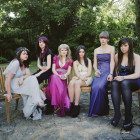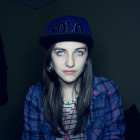About
David Stewart began his career photographing punk bands including The Clash and The Ramones. He also took to photographing the passing parade of colourful characters on Morecambe Promenade with squirrel monkeys Joey and Queenie. This early work directly influenced his now recognisable style.
After graduating from Blackpool and The Fylde College, Stewart moved to London in 1981 where he pursued a career in photography, rapidly establishing himself as one of the UK's most highly accomplished photographers.
In 1995 he directed and produced a short film "Cabbage" which was nominated for a BAFTA. Accompanying the film is a series of surrealist photographic images as a[nbsp]tribute to the much-maligned vegetable.
In 2001 he published a body of work titled "Fogeys" comprising of kitsch, cartoon-like photographs of people growing old disgracefully. Exhibited at the Institute of Contemporary Art London "Fogeys" won a Silver Award at the Art Directors Club of New York.
The book “Thrice Removed” was published in 2009.
While still singular and mischievous, the book includes works that are more muted in colour and personal in tone.
The projects "Indecision" and “Intension” once again return to the surreal, providing an intriguing study of young women.
The book “Teenage Pre-occupation” takes a look at teenagers and the changes they go through and was published in May 2013.
In 2013 the short film “Stray” 2013 was screened at the London Short Film festival.
Stewart won The Taylor Wessing Photographic Portrait Prize in 2015.
He was previously shortlisted for the Photographic Portrait Prize in 2007 and was accepted a further fourteen times between 1995 and 2012, each time exhibited at the National Portrait Gallery, London.
Practice/Statement:
I shoot on a large format camera (8 x 10 or 4 x 5 film) as this brings a heightened sense of reality to the images. This becomes even more apparent when printed large scale for exhibition. The details are clearer and become more important.
Shooting on large format is the way I have always worked. It involves thinking more about what you are about to shoot and then trusting your instinct. With no Polaroid or instant digital image to work with, the pre planning and thought leading up to the shoot are transmitted to the first shot. Shooting in this way can produce a staged image, however in the book "Teenage Pre-occupation" it is subject matter that gives the resulting images a more naturalistic quality, and ultimately the impression of social documentation.


























